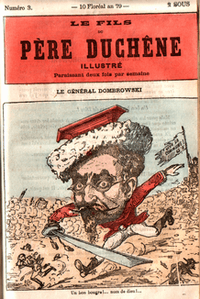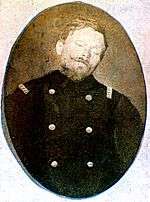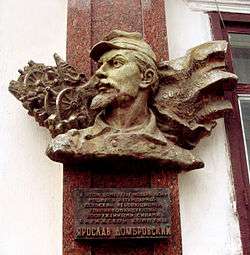Jarosław Dąbrowski
| Jarosław Dąbrowski | |
|---|---|
 | |
| Nickname(s) | Żądło, Łokietek |
| Born |
13 November 1836 Żytomierz, Volhynian governorate, Russian Empire |
| Died |
23 May 1871 (aged 34) Lariboisière Hospital, Paris, Île-de-France province, France |
| Allegiance |
|
| Service/branch |
|
| Rank |
Insurgent leader Commander-in-chief / General |
| Commands held |
Insurgent leader: Commander-in-chief/General: (Communards, National Guard) |
| Battles/wars |
|
Jarosław Żądło-Dąbrowski (Polish pronunciation: [jaˈrɔswaf dɔmˈbrɔfskʲi], also known as Jaroslav Dombrowski; 13 November 1836 – 23 May 1871) was a Polish nobleman and military officer in the Imperial Russian Army, a left-wing independence activist for Poland, and general and military commander of the 1871 Siege and Commune of Paris.[1] He was a participant in the Polish 1863 January Uprising and one of the leaders [2] of the "Red" faction among the insurrectionists as a member of the Central National Committee (Komitet Centralny Narodowy) and the Polish Provisional National Government (Tymczasowy Rząd Narodowy).
Biography
Youth

Dąbrowski was born during the Partitions of Poland in Żytomierz, in the Volhynian governorate of the Russian Empire, in what is now Ukraine. He was the offspring of the old Polish noble family Żądło-Dąbrowski z Dąbrówki h. Radwan.[3][4][5][6] He bore the Clan Radwan arms. His father was Wiktor Żądło-Dąbrowski, coat-of-arms Radwan. His mother was Zofia née Falkenhagen-Zaleska.[7]
Military career

In 1845 at age 9, Dąbrowski joined the Imperial Russian Army, enrolling in the officer training corp at the Brest-Litovsk Fortress, where he spent 8 years. He graduated from the St. Petersburg Cadet Corps in 1855. He fought as a Russian officer against mountaineer uprisings in the Caucasian War. In 1859 he enrolled in the General Staff Academy in St. Petersburg. There he was one of the leaders of the secret "Officers' Committee of the First Army". Members included several hundred Russian and Polish officers, cooperating with the revolutionary "Zemlya i Volya" (Land and Liberty) movement. (Lerski 1996, p. 103). He became involved in the preparation of the January Uprising, but was arrested on 14 August 1862, and exiled to Siberia for his participation in a plot against the Tsar, Alexander II. In 1865, he escaped and fled to France.
On the barricades in Paris


In early March 1871, following months of siege by the Prussians, and social unrest after the Franco-Prussian War, revolution broke out in Paris. The city declared itself independent of the French National Government, calling itself the Paris Commune. Parisians – calling themselves Communards – took immediate steps to defend themselves against the Prussians (who were still in the vicinity) and against the deposed Monarchists, seeking a return to Louis Napoleon's Third Empire. By this time, Dąbrowski had been elected to the Council of the Paris Commune, using the nom de guerre, Jaroslav Dombrowski.[8] When negotiations with the National Government broke down, he became Commander-in-Chief and started organising its defence. Mortally wounded on the barricades, he died on 23 May 1871, in the Lariboisière Hospital of his adopted city. After he was killed, the Communards presented arms with un-communard precision.[9] The Commune itself fell on 28 May 1871. The subsequent massacres of the Communards by the French National Government shocked liberal society throughout Europe.[10]
Legacy

Several schools and roads are named after him in Poland; among them most notable is the Military University of Technology in Warsaw.[11] In the Spanish Civil War (1936–1939), – the Dabrowski Battalion and various Brigade-strength units (known in Polish as the Dąbrowszczacy) – were named in his honour. See Polish Volunteers in the Spanish Civil War.
See also
References
- ↑ (Zdrada 1973, p. 9).
- ↑ Joseph Conrad's Heart of Darkness. Taylor & Francis. September 20, 2007. p. 160.
- ↑ Zdrada, Jerzy (1973). Jarosław Dąbrowski 1836-1871. Kraków: Wydawnictwo Literackie. pp. 9–10.
Jarosław Radwan Żądło Dąbrowski urodzil się 13 listopada 1836 roku Żytomierzu na Wołyniu. Rodzina Dąbrowskich wywodziła się z Mazowsza, najprawdopodobniej ze wsi Dąbrówka pod Piasecznem w ziemi warszawskiej. Notują ją herbarze szlacheckie od XV wieku, ale była to zawsze szlachta dość uboga, w niektórych tylko okresach dochodząca do pewnej zamożności. Nigdy też nie dostąpili Dąbrowscy ważniejszych urzędów i godności, zadowalając się w latach istnienia Rzeczypospolitej komornictwami, skarbnikostwem, wojskostwem, miecznikostwem czy stolnikostwem. Nie brak też było w rodzinie duchownych. Rozrastającemu się rodowi Żądło-Dąbrowskich szybko zrobiło się ciasno na ubogim Mazowszu. W ciągu XVI i XVII wieku zaczęto się przenosić, głównie dzięki małżeństwom, w inne zakątki Rzeczypospolitej. Tym też sposobem jedna z gałęzi rodu Dąbrowskich w końcu XVIII wieku zakorzeniła się na Wołyniu. ... Matka Zofia z Falkenhagen-Zaleskich pochodziła ze spolszczonej od dawna rodziny inflanckiej i była siostrą Piotra Falkenhagen-Zaleskiego, emigranta z 1831 roku, cenionego ekonomisty tych czasów. Przez żonę Piotra, Marię z Korzeniowskich, byli Dąbrowscy spowinowaceni ze znanym pisarzem Józefem Korzeniowskim.
- ↑ Okolski, herbu Rawicz, Szymon (15 September 1643). "RADWAN alias WIRBO". ORBIS POLONUS (in Latin). Kraków, Kraków voivodeship, Lesser Poland province, Kingdom of Poland and the Grand Duchy of Lithuania: Franciscus Caesarius. II: 564. Archived from the original on 8 June 2017. Retrieved 8 June 2017.
LINEA FAMILIAE RADWAN
- ↑ Okolski, herbu Rawicz, Szymon (15 September 1643). "RADWAN alias WIRBOW". ORBIS POLONUS (in Latin). Kraków, Kraków voivodeship, Lesser Poland province, Kingdom of Poland and the Grand Duchy of Lithuania: Franciscus Caesarius. II: 572. Archived from the original on 8 June 2017. Retrieved 8 June 2017.
Dąbrowfcij, cognominati Zedlowie ...
- ↑ Boniecki (Fredro-Boniecki), herbu Bończa, Adam Józef Feliks (1901). "DĄBROWSCY h. RADWAN z Dąbrówki" (online book). Herbarz Polski - Część I.; Wiadomości Historyczno-Genealogiczne O Rodach Szlacheckich. Warsaw, Warsaw governorate, Vistula land (Russian POLAND), Russian Empire: Gebethner i Wolff. IV.: 147.
DĄBROWSCY h. RADWAN z Dąbrówki pod Piasecznem, w ziemi warszawskiej, w różnych stronach osiedli, przeważnie w ziemi rożańskiej. Przydomek ich „Żądło“. Żyjący w połowie XV-go wieku Jakób z Dąbrówki, ...
- ↑ (Zdrada 1973, pp. 9–10).
- ↑ Petit Robert: Noms Propres
- ↑ Horne, Alistair. The Fall of Paris. New York: St. Martin's Press. p. 380.
- ↑ (Billington 1980, p. 613)
- ↑ "Wojskowa Akademia Techniczna Warszawa ul. Gen. Sylwestra Kaliskiego 2". szkolnictwo.pl.
Bibliography
- Billington, James H. (1980), Fire in the Minds of Men: Origins of the Revolutionary Faith, New York: Basic Books.
- Lerski, Jerzy J. (1996), Historical Dictionary of Poland, 966-1945, Westport, Connecticut: Greenwood Press.
- Zdrada, Jerzy (1973), JAROSŁAW DĄBROWSKI: 1836–1871, Kraców, POLSKA: Wydawnictwo Literackie.
External links
- The Library of Congress: James Hadley Billington
- Theme music from the movie: JAROSŁAW DĄBROWSKI (1976); Music by Wojciech Kilar
- Movie (in Polish): JAROSŁAW DĄBROWSKI (released: 26 January 1976) directed by Bohdan Poręba (length: 2 hours, 12 minutes)
- (SEA VESSEL) S.S. JAROSŁAW DĄBROWSKI: Built: 1950; Gross Tonnage: 3,196; Deadweight Tonnage: 2,667; Builder: Blyth Shipbuilding Company, Blyth, Northumberland county, England, UK; Owner: Polish Ocean Lines, Gdynia, Pomerania province, Poland
- (SEA VESSEL) S.S. JAROSŁAW DĄBROWSKI: Rendsburg, Rendsburg-Eckernförde district, Schleswig-Holstein state, Kiel Canal, Germany; 04-September-1966; Built: 1950; Gross Tonnage: 3,196; Deadweight Tonnage: 2,667; Builder: Blyth Shipbuilding Company, Blyth, Northumberland county, England, UK; Owner: Polish Ocean Lines, Gdynia, Pomerania province, Poland
- Banknote, featuring JAROSŁAW DĄBROWSKI - Denomination: 200 złoty; Country of Issue: Poland; Year Issued: 1986
| Wikimedia Commons has media related to Dąbrowski (Żądło-Dąbrowski, h. Radwan) family. |
| Wikimedia Commons has media related to Generals of Poland. |
